Kadazan People

Judul : Kadazan People
link : Kadazan People
Kadazan People

1.0 INTRODUCTION.
Kadazan is the indigenous tribes of Sabah, Malaysia. They live in the interior, around the local area and particularly the west coast of Sabah. Kadazan
are the largest ethnic group, about 80% of the people of Sabah. Kadazan ethnic groups use different languages and dialects with various cultural and
traditional customs. There are 27 tribes in it. Among them are the Dusun Liwan, Dusun Tindal, Dusun Pahu, Dusun Lotud, Bagahak, Dusun Labuk, Dusun
Kimaragang, Tagahas, Tangara, Dusun, Rungus, Orang Sungai, Kuijau, Tambanuo, and so on. Because of similarities in culture and language with the Dusun
ethnic groups, as well as other political initiatives, the new term together called "Kadazan-Dusun" was created. Collectively, they form the largest
ethnic group in Sabah. There are many theories about the origins of the word 'Kadazan'. There are theories that say it is from the word "kakadazan"
which means city.It is believed that the word also comes from the word "Kedayan" the name of ethnic groups living in Brunei and Labuan yang most known
as orang-orang dusun. Kadazan also believed mean people. Some say the words is designed by politicians.[1] [i]
2.0 THE LEGEND OF “NUNUK RAGANG”
It was said that the Kadazan/Dusun people originated from a place called ‘Nunuk Ragang’. Complete records of Nunuk Ragang were long-lost but what
remain are only the theories of Social Sciences and the story of the legend. Popular legend story shows that the Kadazan came from this place - "NUNUK
RAGANG". This place is situated in an area around the mouth of the confluence of two rivers with the rivers Kogibangan (from the left) and River
Kawananan (from right), which was merged into a larger river, called River Liwogu (deep and Quiet). It was covered with a "board that looks red"
respectively by the antics and behavior. Additionally, under the trees on the banks of the river and above all full of thick roots of Nunuk there are
full of that board. Reflected color "red" is accentuated when the sun shines into the body of the boards. Therefore, the Nunuk seemed "red" and he
called Nunuk Ragang. (Aragang / Ragang (Bahasa Kadazandusun) = Red. The notion of, Nunuk the Red, or Nunuk Ragang is a metaphor to describe how many
people (red board) who rejoice in the vicinity of this Nunuk. Basically, a lot of people conveyed the tree as "red" when they viewed it from a distance
and it is not because the colour of Nunuk tree is actual red. Since then, the name NUNUK RAGANG has become "identity" of the people of Sabah who
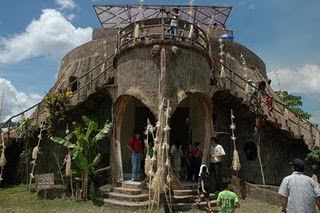
A replica of Nunuk Ragang in Ranau
3.0 ECONOMIC OF KADAZAN PEOPLE
3.1 Farming
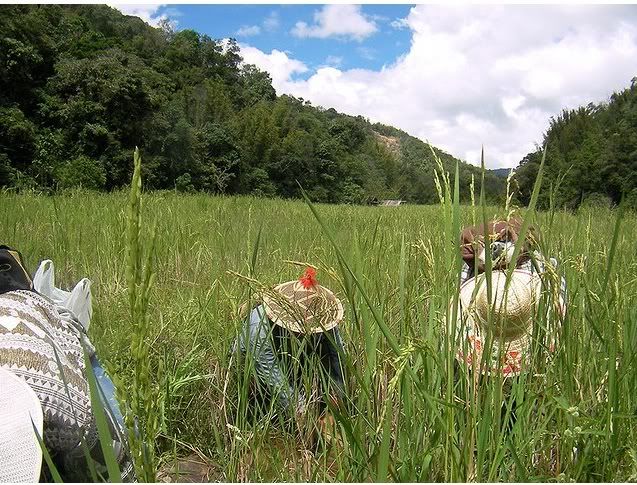
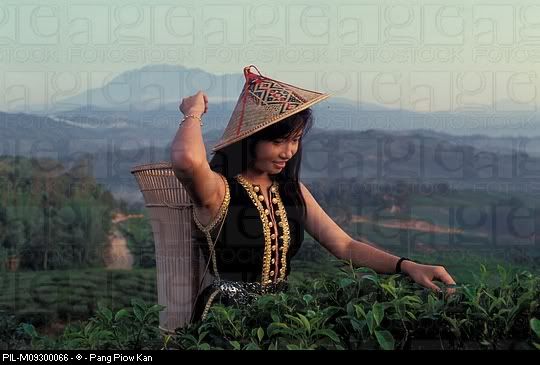
Since time immemorial, the Kadazan community known as rice farmers and a major producer of rice in Sabah. They harvest rice using traditional methods such as using a sickle, knives and "linggaman". In the past they practice nomadic farming. They keep the rice in the rice huts and place it in the rice granary called "tangkop". They plowed fields by using the old way using buffalo energy and hoe. However, in some places with the advances in agricultural technology, they began to use tractors to plow the fields. Besides planting rice paddy fields and hills, Kadazan people also planting corn, cassava, tobacco and vegetables such as sweet temu, spinach, pumpkins, petola, beans, peppers and chillies. These crops they planted around the house. In the area Kundasang, where the climate is cold, Kadazan people planting a variety of cool-climate vegetables like cabbage and asparagus. In addition, they also plants fruits like pineapple, jackfruit, "tarap", banana, mango, papaya, coconut, "bambaangan", orange, red guava and rambutan. These fruits are plant around the house, garden and in fruit orchards located in the hills areas.
3.2 Husbandry And Hunting
Kadazan people rear pigs, chickens, goats, ducks, cows, goats and geese. Livestock is often sacrificed at the time they celebrate a festival or at a
time when they held a ritual. Besides that Kadazan tribes also hunt for their living. Typically, the animals that they hunt is as wild boar,
tapir, foxes, rock badgers, foxes, monkeys and various bird species using the gun, the traditional trap "sunggul", "kisap", "tuwil", "gado" and other
and rifle called "bakakuk". In the past, they hunt with bamboo blowpipe, snares, traps, spears and hunting dogs. As a result of the hunting activity,
the economic activities are of their side.
3.3 Fishing
Other than those activities mention above, the Kadazan people also catch fish in paddy fields, ponds and rivers with nets, fishing nets and fishing
gear such as the traditional "siud", "SAVAK", traps, "bangkala" and "tambong". Kadazan people from Tatana tribes at the district of Kuala Penyu, is one
of tribe that worked as a fisherman.
3.4 Collecting Forest Products
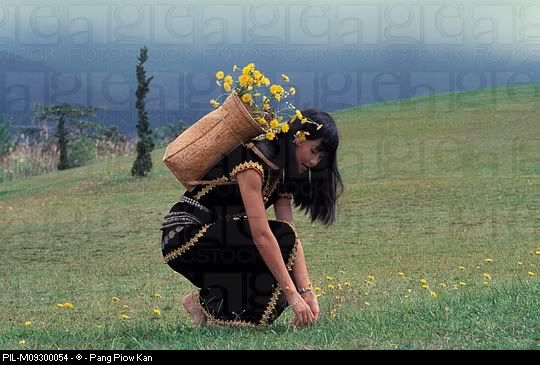
Kadazan People, especially those living in interior areas of the state take woods and bamboos to make fences. In addition, they also take Pandanus
leaves woven into mats and baskets. Fruits, vegetables and fish products, and hunting resources is for their daily needs, but often it is also sold at
4.0 CULTURE OF KADAZAN PEOPLE
4.1 Traditional Clothing
With a native ethnic tribe in Sabah, it is expected, there are various types of clothing in accordance with tribal traditions. Most of them have
retained the tradition of pattern and color of the original. A very popular color is black. These colors, widely used, because in the past, a native of
the state only depends on a number of crops and vegetables to make liquid fabric dye. They just need to add a variety of bead colors like red, orange,
white and green as an additional decoration. Manuk costume also includes a quick and antique beads necklaces, belts, carved antique silver and belts
made of silver dollar coins. All of these treasures of hereditary very valuable and highly valued. Here are some examples of the Kadazan tribe
4.1.1 Characteristics Of Traditional Clothing.
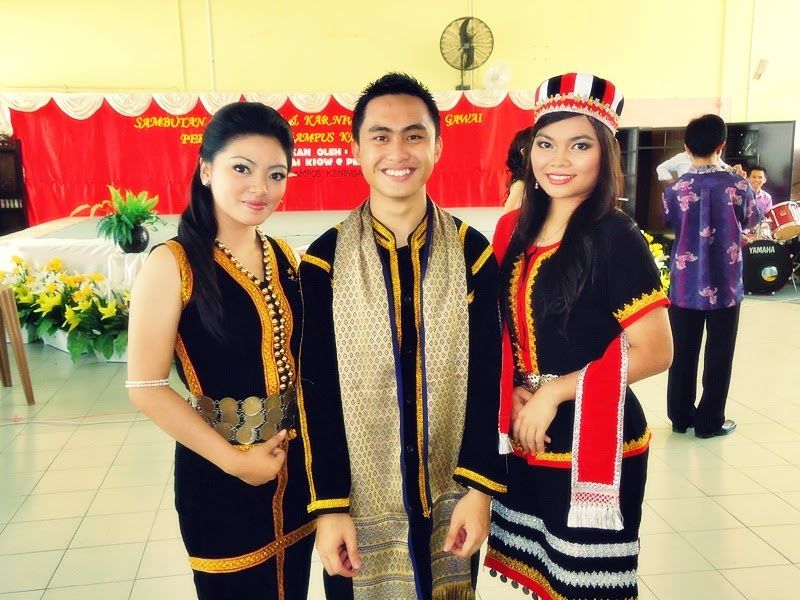
- Blouse black velvet sleeveless for women (Sinuangga), short sleeve for middle-aged women (Sinompukung) and long-sleeves for old women especially 'bobohizan' (Kinoingan).
- Black velvet shirt, or long for the men.
4.2 Harvest Festival
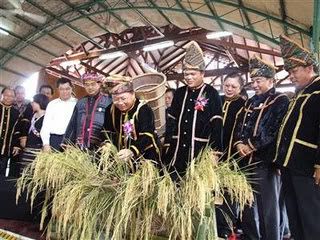
Harvest Festival (Tadau Kaamatan) or in the Kadazan language "Magavau" is a special celebration ceremony to honor the "Bambazon" the spirit of the
rice. This festival is a traditional practice Kadazan-Dusun people since time immemorial. Feast "Magavau" is usually held after the completion of the
rice harvest. Harvest Festival is celebrated today has been approved by the Legislative Council of the Colony as a public holiday by 1960 Sabah, Tun
Fuad Stephens Mohamad Hajj, the first Chief Minister of Sabah. Among the interesting celebration was held Sumazau performances and dance competitions.
This dance is danced by the peasants made up of men and women wearing their traditional dress. The dance is accompanied by gongs played. This dance
is performed with both hands raised to shoulder level and waving like a bird's wings, follow by rhythmic tunes played. Apart from Sumazau dance,
singing contest held also called Sugandoi, bodybuilding shows and beauty pageants or "Unduk Ngadau", and offering all kinds of arts and crafts.
Competition such as beating drums and sports people also become one of the major events in the festival.[5] [v]
4.3 Music And Traditional Dance.
Sabah had thirty-two types of ethnic, fifty-five languages and about a hundred dialects. Each has a cultural and ethnic traditions of its own. They
show their way of life through music and dance. Among the tribal dances of Kadazan in Sabah is as below.[6] [vi]
4.3.1 Traditional Dance.
- Sumazau Penampang
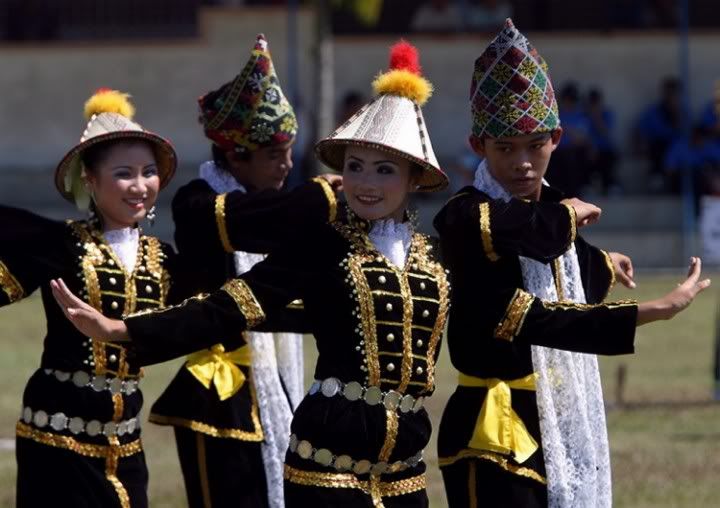
Sumazau Penampang is a traditional dance Kadazan tribe. This dance is usually performed during the festival and ritual spirit of rice (Bambaazon).
Dancers perform their dance in pairs. Both male and female dancers began dancing with the rhythm of a gentle and slow as the gong. With 'pangkis' of a
male dancer usually indicates a change in the pattern of the dance will be performed. 'Pangkis' of the male dancer will be more than enliven the dance.
Clothing worn by the dancers is dressed all in black with golden yellow stripes. The female dancers wear tangkong ',' tinggot ', and' Himpogot '. Male
dancers wear 'sigar' in the head. This dance is usually accompanied by gongs or 'togunggu'.
- Mogunatip
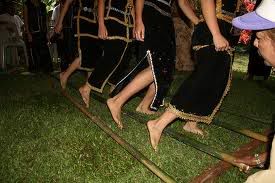
Mogunatip is a dance performed by the natives of the interior including the Kadazan from Tambunan, Kwijau Dusun from Keningau and several groups of Murut tribes. Magunatip is derived from the word "atip meaning 'to press between two surfaces. Dancers Magunatip requires skill and agility to dance the bamboo are hit together to produce the rhythm of the dance. It is a dance that is performed during certain ceremonies to honor guests.
Furthermore, the Kadazan tribe traditional dance is Liliput, Menangkuk, Mongigol, Sumundai, Paina SUMAYAU (Mongigol Tuaran) and Titikas. This dance is
4.3.2 Traditional Music
Most of the musical instruments of Sabah made from natural materials. For example, tongkungon, turali, suling (or flute), sompoton and togunggak made
from bamboo. Tools such as fiddle, kompang and a drum made of goatskin. Gong and kulintangan made of soft wood and resemble long-stringed
guitar made out giman, a type of palm tree fibers. The musical instruments of Sabah, classified into;
- Kordofon - (tongkungon, harps, sundatang or gagayan)
- Erofon - (flute, turali or tuahi, bungkau and sompoton)
- Idofon - (togunggak, gongs, kulintangan) and membranofon (drums, drum or tontog).
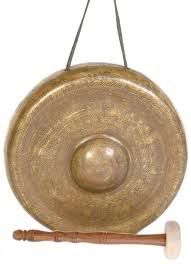
GONG
Gong is the backbone of most of the music arena and it is used in almost every social occasion.
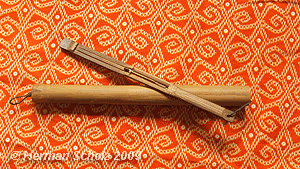
Bungkau
mouth flute made from the bark of a palm tree known as polod the Kadazan tribe.
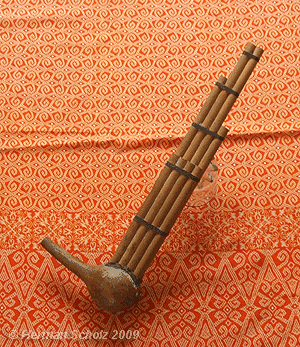
SOMPOTON
(Erofon)
Mouth organ is the most fascinating of the local musical instruments in Sabah.
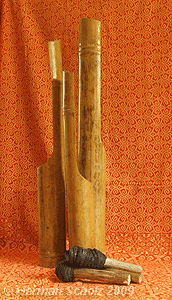
TOGUNGGAK
(idiofon)
Idiofon scourge of bamboo is played in the group to escort dance or march in the festivities.
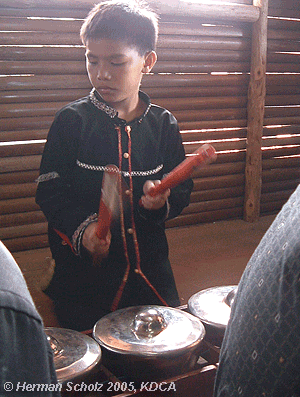
KULINTANGAN
(Idiofon)
traditionally used by the Bajau and some Dusun / Kadazan.
5.0 CUISINE
Kadazan people’s of Sabah ethnic has a tradition of hereditary from generation to generation and is still practiced to this day.Among the famous
traditional food Kadazandusun is Hinava, Noonsom, manuk Lihing Pinaasakan and soup. This meal can be prepared in various ways according to common
tradition Kadazan people.
HINAVA
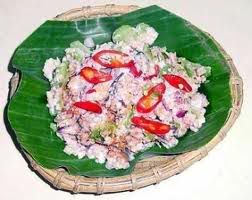
Hinava Ginapan is one of the special traditional dishes of ethnic Kadazan-Dusun , Sabah , and may be regarded as a most popular food among the Kadazan-Dusun. It is a dish made from fresh fish meat is mixed with fruits, pound that has been shredded, red chillies, ginger , onion, lime cotton and salt. The contents of these fish do not need to be cooked because it will cook with the juice squeezed lemon or lime if using lime (like shushi). There are many types of fish that can be used, but usually the content of mackerel, shark although the content can also be used. Besides the content of squid or shrimp can also be used for the preparation of this Hinava . Hivana usually a dish while Tadau Kaamatan. In addition it is also a special meal on
important occasions such as for weddings, engagements, etc.
Pinaasakan
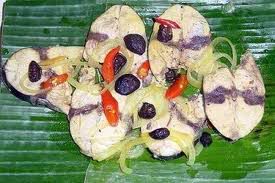
Pinaasakan is
one of the local dishes served quite often during meal times in a family household. This food rarely can see these days if not during festive season
like Kaamatan.
NOONSOM
Noonsom is well known as “pickle” in the English language. There are several types Noonsom introduced by the Kadazan people. Among the most popular is:
- Noonsom Sada (Fish).
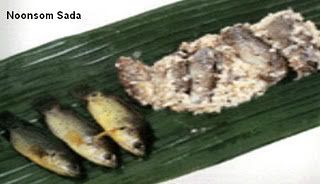
Fish that were used are the type of freshwater fish, cleaned and preserved using Pangi pulp (crushed), rice and salt.
- Noonsom Bambangan .
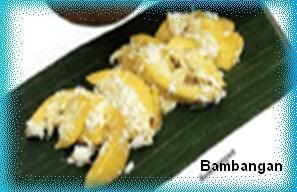
Bambangan is one of the kadazan dusun people's choices for a sour tang to their food.
- Noonsom Tuhau.
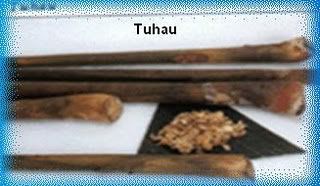 Tuhau content are being sliced and pickled with vinegar, salt and red chillies.
Tuhau content are being sliced and pickled with vinegar, salt and red chillies.SUP MANUK LIHING
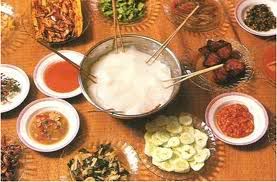
Better known as 'Chicken Soup Lihing' in the Malay language is a special traditional dishes of ethnic Kadazan-Dusun , Sabah . Materials required are a chicken village, a liquor which is called 'Lihing' among the Kadazan and sliced ginger. How to prepare, cooked chicken meat that has been cut by half a cup lihing, sliced ginger, salt and seasoning powder. Let it boil until the chicken just before serving gently. By tradition the Kadazan-Dusun, the food is very suitable for the new women after childbirth. Many traditional ethnic foods Kadazandusun today can be found in common a certain number of restaurants providing local food traditions. In addition, some leading hotels are also chosen to serve ' Hinava 'as special dishes for the visitors. The uniqueness and diversity of food traditions introduced by the local community Sabah today is one of the privileges available in the land below the wind. [8] [viii]
Tapai
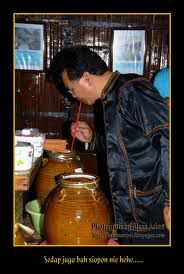
For the Kadazandusun community, Tapai(rice wine) is a traditional drink that needs to be in life as a symbol or practice that has been done over many generations. Tapai has become synonymous with the Kadazandusun community. Among the factors drinking culture is the belief in the spirit of fermented rice (Harvest Festival), customs, marriage ceremony, gatherings, open house, entertaining event, the opening before the discussion fiancee, death, mutual assistance, etc.
6.0 LANGUAGE OF KADAZAN PEOPLE
Rationally Kadazan language has existed since their ancestors, at first use of the native languages is a branch of every human interaction, deliver
and receive information. In particular, the spread of such dialects are starting from a small community groups. These groups communicate and develop an
understanding of identity through their language. Eventually it will grow through the diffusion and increase the quantity of these groups. Originally
the Kadazan community groups are in small amount, over time it evolved into large clusters. Kadazan tribe has its own language. Kadazan tribes and
Dusun tribes are actually a different tribe, but were of the same family. Language of both these tribes nearly the same, distinguished only by minor
differences in spelling and pronunciation.
For example, "home" as "walai" in Dusun and "hamin" in Kadazan. Many other words that differ only in spelling such as "two" the "duo" in Dusun and
"duvo" in Kadazan, and "nine" referred to "siam" in Dusun, and "sizam" in Kadazan. However, there is the same word as "a" the "iso" in both languages
and "six" is "onom".
Despite the Kadazan language has many dialects based on Bunduliwan dialects, they all understand each other. Kadazan language can be divided into four
dialect groups as follows;
- Kadazan West Coast dialects
- Kadazan East Coast dialects
- Kadazan North dialects
- Kadazan Interior dialects[9] [ix]
7.0 RELIGION OF KADAZAN PEOPLE
Kadazan majority is Christian, mainly Roman Catholic and some protestan. Islam is also practiced by a growing minority. Before the influence of British
missionaries in the mid-19th century up to be famous among the Kadazan, animism is the religion of their major. Kadazan people believe in the spirit or
soul that is called Kinoingan. It revolves around the ruling spirits of rice planting and harvesting has been practiced from generation to generation.
Special rituals would be performed before and after each harvest by a tribal priestess known as a bobohizan.[10] [x]
7.1 Kapir (paganism) – (The Kadazan/Dusuns' Religion before Christianity)
The Kadazan individual family or community as a ritual isolate is in constant interaction with the spirit world. This involves a number of sacrificial ceremonies to create a balanced ritual state between the kadazan/Dusuns and those numbers of the spirit world.
The Kadazan/Dusuns believe in four principal spirits:
i) "Minamanngun / Kinorohingan or Kinoingan" - the Almighty creator
ii) "Koduduwo/ Koduduvo"- a living person's spirit
iii) "Tombiruoh/Tombivo" - the ghostly spirit of the dead
iv) "Rogon"- the evil spirits
7.2 Bobohizan
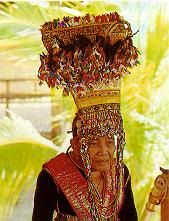
Bobohizan is the title of the main female healer in the tradition of the Kadazan Dusun culture. Bobohizan play an important role in the Tadau Kaamatan
for worship site to ensure plants are successful crop next year. Bobohizan the first reliable taught by the spirit of transformation Huminodun, the Unduk Ngadau, curse spells practiced until now. Many bobohizan consists of women, but there are a number of men chosen to reinforce the presentation or ceremony held. Feared that the spirits who came not to be repelled.
8.0 POLITIC OF KADAZAN PEOPLE
The need for the Kadazan-Dusun to be united was something everyone talked about. Though the split between Kadazan and Dusun does not seem so deep
anymore, the Kadazan-Dusun are divided into several political parties, something which many see as a problem. When asked of the challenges for the
Kadazan-Dusun, Abdullah replied: “...politically, they must find a solution to be really united ”. This was a view reflected in several other
responses. The issue of party-hopping was often referred to. In the 1994 state elections, PBS won an arrow victory over UMNO. But the victory became
defeat when, one after another, all but five of the PBS defected to form new parties within the BN fold. The buying of assemblymen by means of
according positions of power and pure cash gifts is a rather common practice in Sabah. The defectors also cited difficulties in cooperating with
Pairin, who did not have much choice but to resign as chief minister (Mohammad op cit). A new host of defections came after the 1999 elections, which
PBS also lost from the start (Far Eastern Economic Review, 25 Mar. 1999). The voters, especially the Kadazan-Dusun community, were angered by the
defections. To the respondents, the disunity was because of the self-interests pursued by the leaders: They don’t have any more value to become a
leader. They’re just changing politics and then political party as they please. They never think about their own people or what kind of value that
they’re trying to practise now. There is thus a lack of confidence in politicians, who are generally seen more as obstacles than bearers of
Kadazan-Dusun unity. A common denominator was also that the political system as such was flawed and was standing in the way of Kadazan-Dusun unity.
From a Western perspective, the Malaysian democracy has some serious shortcomings, although this is not a place to elaborate further on them.What is
perhaps most interesting from this perspective is a view that this system like so much else has been imposed from outside (cf. p. 41) and that the KD
would be able to create a fairer and more unifying one themselves. But as should be obvious from the previous text, there are disagreements on what to
unite behind.
Indigenous status.
Being indigenous to Sabah, a part of Malaysia, the Kadazans are conferred the same political, educational and economic rights as the predominant Malay
9.0 CONCLUSION
Kadazan is the largest ethnic group in Sabah. Kadazan ethnic group use different languages and dialects with various cultural and traditional customs.
Kadazan culture is mostly influenced by the activities such as rice farming, rearing animal, hunting, collecting forest product and some of them work
as fisherman.
Kadazan also have their own culture. They have an identity that shows through their clothing, music and dance culture. For example, Keaamatan Festival
is a religious ceremony done by them every year after and before the rice harvest to honor the spirit and drive the evil spirits.
Besides that, although the Kadazan language has many dialects but all of them could understand each other through ‘Bunduliwan dialect’. It is also
important to know that, Kadazan language can be divided into four dialect groups such as, Kadazan West Coast dialects, Kadazan East Coast dialects,
Kadazan North dialects and Kadazan Interior dialects.
As for the religion view, it is known that the majority of the Kadazan are Christians, mainly Roman Catholics and some Protestants. However, there are
minorities who practice Islam as their way of life and the group is growing. Before the missionaries came into scene, animism was the predominant
religion for the Kadazan.
With regard to the indigenous tribe of Kadazan, they are associated together with another similar indigenous tribe, the Dusuns and various other
indigenous peoples, under the blanket term Kadazan-Dusun. This decision are made due to the reason of sentiment politicized during 1960s involving
crisis of Kaadazanism versus Dusunism which had affect badly the economic, the politic and the community as a whole. In order to prove that the Kadazan
is part of the Malaysian community, their rights as to the politic, economy and education are given equally as the Malay population in Peninsular
Malaysia. Therefore, based on the above statement, we can conclude that the Kadazan had much improved from generation to generation through their
economics, politics, culture and education.
10.0 BIBLIOGRAPHY
Tunggolou, Richard. "The origins and meanings of the terms "Kadazan" and "Dusun".", KDCA Publications. December 2, 2004.
SEJARAH ASAL USUL MASYARAKAT KADAZANDUSUNMELALUI SUMBER LISAN (CERITA) DAN FORUMEdited By: Fred Apat (mrfred85@gmail.com)
http://members.fortunecity.com/mpsdk/page6.htm
http://www.sabah.edu.my/skm015.wcdd/pakaian.htm
http://www.sabah.edu.my/skm015.wcdd/Kaamatan.htm
http://www.sabah.edu.my/skm015.wcdd/muzik.htm
http://www.sabah.edu.my/skm015.wcdd/tarian.htm
http://seleramelayu.clanteam.com/sabah.html
Tunggolou, Richard. "The origins and meanings of the terms "Kadazan" and "Dusun".", KDCA Publications. December 2, 2004.
SEJARAH ASAL USUL MASYARAKAT KADAZANDUSUNMELALUI SUMBER LISAN (CERITA) DAN FORUMEdited By: Fred Apat (mrfred85@gmail.com)
http://www.facebook.com/topic.php?uid=18965765082&topic=14295

Demikianlah Artikel Kadazan People
Sekianlah artikel Kadazan People kali ini, mudah-mudahan bisa memberi manfaat untuk anda semua. baiklah, sampai jumpa di postingan artikel lainnya.
Anda sekarang membaca artikel Kadazan People dengan alamat link http://cheatterbaru2.blogspot.com/2011/12/kadazan-people.html

